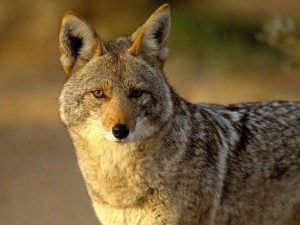A handful of coyote sightings in developed neighborhoods around St. Michael and Albertville have residents wondering what they can do about the critters roaming through backyards and drainage areas.
True, coyotes have always called the prairie home, but it seems in recent years they’ve adapted to living in urban developments that have open spaces for them to roam, such as the Highlands area in central St. Michael or Meadow Ponds on the east side of town. In Albertville, areas out by Towne Lakes are prime roaming areas for pups of the wilder variety?
 Is there a risk? According to the Minnesota Department of Natural Resources, not to residents themselves. Coyotes will rarely confront a human, though it has been reported from time to time in other urban areas. An Edina news story talked of a jogger on a path who was confronted by a ‘yote, as the mom was separated from her pups. No chase ensued after the runner turned and headed a different direction.
Is there a risk? According to the Minnesota Department of Natural Resources, not to residents themselves. Coyotes will rarely confront a human, though it has been reported from time to time in other urban areas. An Edina news story talked of a jogger on a path who was confronted by a ‘yote, as the mom was separated from her pups. No chase ensued after the runner turned and headed a different direction.
But, coyotes can be a nuisance. They won’t necessarily hunt small dog breeds if there’s plenty of other things to hunt in the area, but they can t backyard friends of the domestic variety. And, if hungry, coyotes will take out a garbage can or two to nose through some trash.
Here are some guidelines issued by the DNR for dealing with so-called “urban coyotes:”
Coyotes are wild members of the dog family, intermediate in size between red foxes and wolves. In Minnesota, coyotes average 30 pounds, and stand about 18 inches high at the shoulders. However, they may appear much larger due to their heavy fur coat, especially in winter. They are gray/brown in color, and somewhat resemble a small German Shepherd dog in appearance. Coyotes in Minnesota are loners, except when families are raising pups. Their primary foods are rabbits and mice, but they are very opportunistic, and will feed on other small mammals, deer, birds, carrion, and even melons.
Although coyotes can be found anywhere in Minnesota, distribution and population size is variable. Currently, populations are establishing and increasing in the Twin Cities metro area.
Most coyotes avoid people and domestic animals, but occasionally they will kill sheep, turkeys, and calves. They may also raid garbage cans, and kill domestic cats and small dogs. Healthy wild coyotes avoid people, and no attacks have ever occurred in Minnesota. However, attacks by urban coyotes have been reported in other states. Experts believe these attacks occur after a coyote has become accustomed to humans, or after being fed by humans.
If you are concerned about the presence of coyotes where you live, consider the following do’s and don’ts:
DO:
- secure all garbage containers, wildlife feeders, and other food sources to prevent coyote access
- confine small dogs and cats in kennels, or supervise them when outside
- vaccinate all pets for rabies, distemper, parvo, and other diseases, as recommended by a veterinarian
- consider installing coyote-proof fencing
- harass (by chasing, shouting, etc.) any coyotes that do not immediately run from people
DON’T:
- do not feed coyotes
- do not leave pet food outside
- do not allow cats and small dogs outside, unattended
These simple suggestions should prevent most coyote problems. However, if depredation occurs or aggressive coyote behavior is observed, removal of the coyotes may be necessary. Coyotes are unprotected in Minnesota, and may be taken at any time by shooting or trapping, without a license or permit.
The Minnesota Department of Natural Resources does not trap, shoot, or relocate coyotes. Where necessary, removal of coyotes is the responsibility of the landowner or tenant. For information on pest control contractors or trapping techniques for coyote removal, contact your local DNR Wildlife office or Conservation Officer. In cities with ordinances prohibiting the use of certain traps and/or firearms, you may need a city permit, or assistance from the city/county animal control agency.